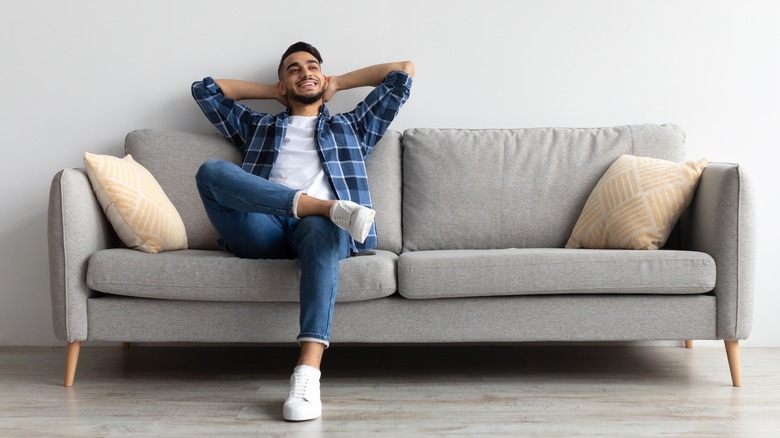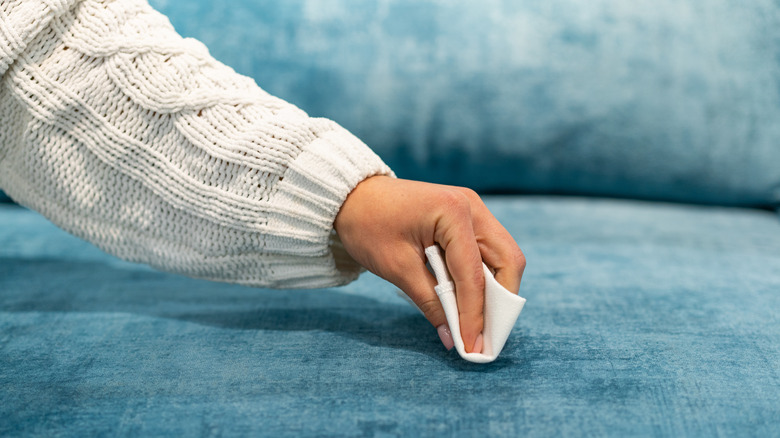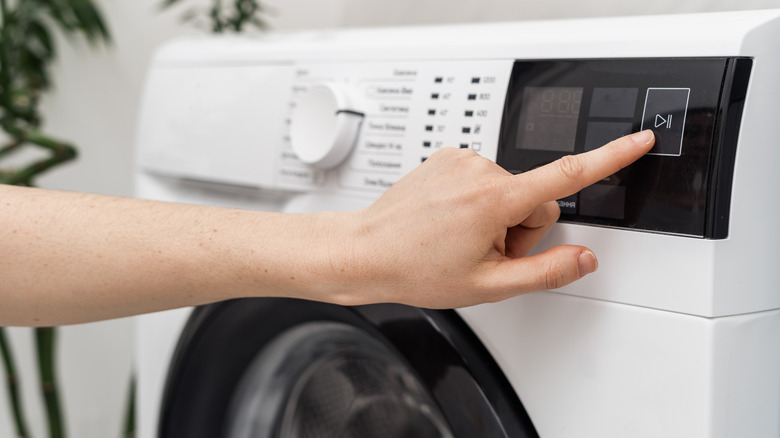How To Properly Clean Your Couch Cushions
Couch cushions have a habit of sucking up lost items. Next time you're scanning the room for your missing phone, make sure to dig through the sofa. Who knows what else you may uncover in the search: a missing pencil, dusty AirPods, or, like one California woman, $36,000 in cash forgotten by the previous owner (via ABC 7 News). Though encountering a stack of bills is admittedly unlikely, you'll definitely be rewarded with a handful of year-old crumbs or crumpled-up receipts. Couches, despite being one of the most trafficked areas in our homes, are one of those things you should be cleaning but, if we're being honest, probably aren't. Reporting on a study commissioned by Furniture Village, House Beautiful claimed that our at home sofas have an average lifespan of 11 years, witnessing "couples kiss 2,105 times, families sit down to watch 3,135 films, and 2,299 hours –- which equals to almost 96 days — of phone conversations." With all this time spent on our couch cushions, it's important that we keep them clean (and free of loose change).
To properly begin the cleaning process, keep in mind that all fabrics and styles of slip covers require different treatments. For some, this may be as simple as turning on your washing machine. For other couches, especially those where the cushion cover is not easily removable, it's a bit more complicated.
Spot clean couch cushions with an at-home solution
Given the right ingredients, getting rid of cushion stains is relatively simple. Whatever fabric trend you've decided to embrace, be it linen, velvet, or polyester, start the process by brushing away debris. As Grove Collaborative experts Angela Bell and Georgia Dixon told Food52, "Using a vacuum with an upholstery head attachment is a great way to remove food particles so that they don't smudge any grease or food into the upholstery." In a pinch, a lint roller will also do the trick. Once dust or pesky pet hair has been removed from the area, it's safe to start mixing potions. As Bailey Carson, Handy's cleaning and home improvement expert, explained to Food52, most cushion labels will tell you what solutions are safe to use. For instance, "W stands for water, and means the furniture can be cleaned with water-based cleaning products." Likewise, "S stands for solvent, and means it should only be cleaned with a water-free product like a dry-cleaning solvent." If the tag has a combination of the two letters, either method is acceptable. If it has an X, ship it off to the professionals. To make your own water-based cleaning solution, mix 1 cup water with ¼ teaspoon dish soap (via MyDomaine).
Next, as suggested by MyDomaine, gently use a sponge or brush to "work the solution into the soiled area." Scrubbing too hard can make the stain sink deeper, so be sure to use something with soft bristles as well. With plain water, gently wipe away the soapy solution and let the fabric dry.
Thoroughly clean couch cushions in the washing machine
A washing machine can be an effective way to deep clean your cushions, getting rid of stubborn stains once and for all. As slip cover designer Karen Powell told New York Magazine, covers "made with cotton, denim, canvas, linen, polyester, and hemp can easily be machine washed at home with good results." However, Powell warns to first check whether the fabric is preshrunk. If not, the cover may, well, shrink. Other styles to avoid putting in your at-home wash, according to Powell, are "lightweight novelty covers with decorative trim, lined slipcovers, silk and wool slipcovers, and, of course, any slipcover that is labeled 'dry-clean only.'"
According to Food52, it's best to wash cushions in cold water and with regular detergent. Before beginning the cycle, zip up the slip cover to prevent ripping. From here, you're good to go. Once the machine has finished doing its magic, simply air dry the slip to avoid damage in the dryer or additional shrinkage. If you're looking to keep your cushions extra clean in the long term, consider spraying them with fabric protectant. This will act as a barrier between your couch and future spills (via New York Magazine).


